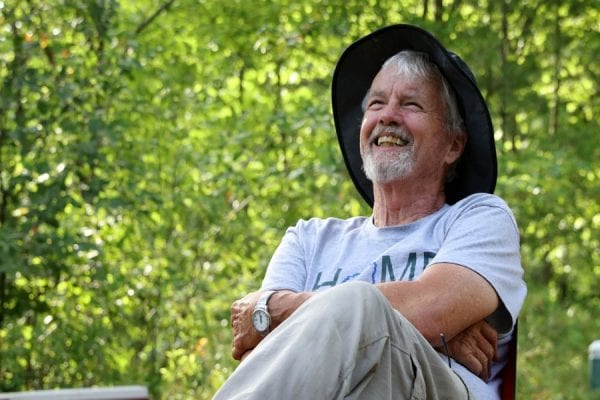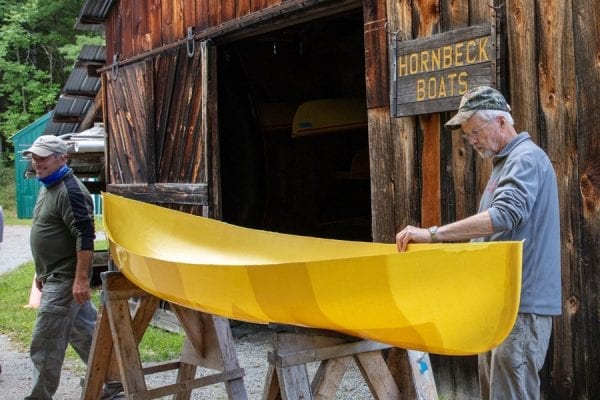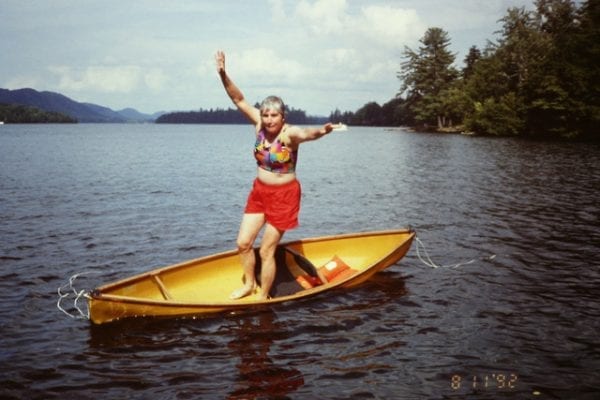Builder’s light canoes and weighty legacy flow through park lore
By Tim Rowland
The boats built by Peter Hornbeck have exhibited legendary toughness, but occasionally an extraordinary and often boneheaded circumstance would lead to a tear in the fabric.
The stories that accompanied the punctured hulls afforded the craftsman no small degree of amusement, and when owners sheepishly brought their boats back to the shop for repair, he was happy to fix them back up for free, on one condition: They had to regale him with the story of how the damage occurred.
It generally involved a hold-my-beer paddle through the rapids into an iron spike, or an encounter with a garage door. Then one day a couple of forest rangers showed up toting a Hornbeck canoe and asking if it could be fixed. On inspection, Hornbeck was surprised to discover the craft was riddled with bullet holes. Oh, this story gets way better. Somehow, where Pete Hornbeck was concerned, stories always did.
Adirondack Renaissance man
The Adirondacks lost Hornbeck to a heart attack the day after Christmas. Hornbeck was a Renaissance man, Adirondack-style, said Dan Way, who, with the loss of Peter, is the last surviving founder of the League of Extraordinary Adirondack Gentlemen (LEAG), a band of philosopher-paddlers plying the park’s crystal blue waters by day and solving the park’s problems around a campfire by night.
Hornbeck built boats, but he also painted in the style of Winslow Homer, told stories in the style of Mark Twain and sought answers in nature in the style of Henry David Thoreau. His name, he said, was derived from a Dutch word for a village by the waters, so he figured boatbuilding was in his blood.
And build he did. And build and build. More interested in fabricating boats than keeping records in the early days, the exact number of Hornbecks turned out by his shop is unknowable, but the best guess is in the neighborhood of 12,500, Way said. It could have been thousands more had he gone corporate, but of course that wasn’t Pete. He preferred to give boats away for charitable fundraisers, or hold his business up as an example of how Adirondack Forest Preserve was conducive to a sound economy.
Stay informed
Keep up to date on the Adirondacks with our slate of topical weekly and daily newsletters
Customer relations
He took studious joy in tailoring each sale to the individual, watching their paddling style on his pond at the complex he called Hornbeckistan, and accommodating their needs. Sometimes he’d watch a husband and wife paddle a tandem and then gently suggest they purchase individual canoes instead. He is credited with saving more than one marriage that way.
He was also wise enough to listen to his own wife, Ann, who took one look at the pale-yellow Kevlar fabric and pronounced that it looked like a floating urine sample. But the Kevlar didn’t take pigment well, so they compromised on a red stripe on the gunwales that is now considered to be almost as iconic in its Adirondackiness as the balsam or the loon.

Hornbeck initially sputtered over that stripe, said Mike Carr, director of the Adirondack Land Trust, because the tape added four unnecessary ounces to a boat whose calling card was its feathery weight. But in time, he came to be fiercely proud of the decoration. When one customer objected to the stripe, Hornbeck was loath to send one of his boats out the door without it. As other boatmakers were entering the lightweight arena, Hornbeck said that was the feature that made his craft distinctive. After considerably more arguing, they compromised. The boat had to go out the door with the stripe, but after that, well, it was a free country. The man got down the drive before, in full view of Pete, he made a great show of peeling off the decal.
Several months later the customer was back for repairs. He had forgotten the boat was on the roof of his car and slammed it into the doorframe of his garage. Hornbeck said he couldn’t repair it, because it wasn’t one of his boats. “What do you mean it’s not one of your boats?” the customer protested. “It can’t be,” Hornbeck responded. “It doesn’t have the red stripe.” Hornbeck fixed the boat, of course. And added back the stripe.

Park lore
The line between Hornbeck the man and Hornbeck the boat is blurry, but tried-and-true Adirondackers say both will certainly go down in Adirondack history, legend and lore. A Hornbeck already hangs in the Adirondack Experience museum, alongside other celebrated crafts including the classic Adirondack guideboat. “He is a major part of Adirondack history,” said Tom Bessette, a LEAG member who maintains a Hornbeck boat fan page on Facebook. “If you know paddling, you know Hornbeck.”
Hornbeck the man reached deep into history to design Hornbeck the boat. In the early days of Adirondack boating, sportsmen paid scant attention to the weight of the boats, because the job of muscling them from one lake to the next fell to a hired guide. But when a diminutive and asthmatic outdoor writer named George Washington Sears took to popularizing self-guided canoe trips in the 1880s, there came a need for a manageable canoe.
For a boat that would meet his needs, Sears turned to Canton boatbuilder John Henry Rushton, who provided a gorgeous wooden craft of elegant simplicity that was only slightly heavier than a Springfield rifle. It had no seat and utilized one double-bladed paddle. Sears had taken the pen name Nessmuk from a childhood Native American friend, and Rushton applied the name to this lightweight canoe as well.
Sears, who had been worked hard as a child and as such had an affinity for Charles Dickens, named his canoe after Sarah Gamp, a drunken nurse in the Dickens novel “Martin Chuzzlewit.” The Sairy Gamp itself became an Adirondack institution, and today it too hangs in the Adirondack Experience—right next to the Hornbeck.
Just a boat
“(Pete) was a little bemused by it,” Bessette said of the acclaim. “He would say, it’s just a boat.’” Yet he was keenly aware of the history, and had himself borrowed from the Rushton design, adding his own interpretation and modern materials.
As a kid growing up in the Buffalo bedroom community of Hamburg, he had begun building boats out of plywood and surplus Army ponchos, tempted—as were many boys of that particular time—by ads in Mechanix Illustrated magazine that promised to sell you a boat for $19.95. For the price, you got a kit that included everything but materials and labor. For the teenage Hornbeck, this began a cycle of building kayak-esque crafts and smashing them to bits on the river. He never saw it as a career.
“I had no experience in boatbuilding, and I came from suburbia, where you don’t learn to do anything practical,” he told a gathering of the Minerva Historical Society in 2019.

He and Ann had traded suburbia for teaching jobs in the Adirondacks, where the ponds and rivers only fueled his boatbuilding bug. Before settling into the remote, blue-collar community of Olmstedville, Hornbeck bought some specialized tools and material in New York City and Boston. He set up a shop in his basement, where he began building and experimenting. Whatever he would set out by the road would sell, but not everything he sold was profitable. Adirondack guideboats, for one, were too labor-intensive.
From Ann’s point of view, the smell was too intensive as well. The more boats Pete built, the more her cookies began to taste like resin. Finally, with a summer balloon payment from her teaching job, she grubstaked Pete to a shop independent of her kitchen.
Boatbuilding by then had become a more attractive pursuit than teaching, which included no small amount of stress—but also a steady paycheck. Then one day nearly 30 years ago, Hornbeck was out on a jog when he felt something wrong in his chest. The only person in Olmstedville who jogged, and he was the one who had a heart attack, he would grouse.
‘Museum of Failure’
Thus commenced the career change heard ’round the Adirondacks, if not the world. Hornbeck began to churn out boats, trying out different materials and styles. Always self-effacing, he seemed to take joy even in his flops, which he held onto in a section of his shop that he labeled the Museum of Failure.
The jokes masked uncertainty in the early years, said his daughter Leigh Hornbeck, whose husband, Josh Trombley, now leads the company. Her dad had borrowed against the house to get through winter. “The boats were popular from the beginning, but the business was not a brilliant success—it took a lot of years to build it up.”
The failures did not come cheap. A mold that didn’t produce the desired result was a setback measured in the thousands of dollars. “It wasn’t like a soufflé that didn’t work out,” Leigh said. Still, her dad remained “doggedly determined.” Ann would have Leigh call him in from the shop at suppertime, and he’d be right back at it before the dishes were cleared.

He was outwardly humble about the effects his boats had on the general public and the way they touched so many lives. After his passing, an impromptu parade of about 60 Horneck-affixed vehicles generated almost spontaneously, parading through the lake communities Pete loved. What would he have thought of that? “He never wanted anything to be about him,” said Bessette’s wife, Kim. “But that said, I think his chest would have swelled with pride.”
Hornbeck’s daughter agreed. “He would have loved it,” she said. “His first reaction would have been blown away; his second reaction would have been, ‘Oh, I don’t deserve this.’ Which was (baloney).”
In his writings, George Washington Sears believed that “the light, single canoe with double-bladed paddle is bound to soon become a leading—if not the leading—feature in summer recreation.” He was right, if 140 years early. And it took Pete Hornbeck to make his vision a reality. The Hornbeck sits as gently on the water as a lotus, the slightest crescent of material between pond and paddler. The low profile is by design; there is less sidewall to catch the wind, more weight down low to create its remarkable stability. The Hornbeck is the meeting point of practicality and status—“Adirondack bling,” Way calls it. “Jewelry you can paddle around on a lake.”

Farewell to an Adirondack Legend
Building a boat with Pete Hornbeck. Photo by Tom Curley
Hornbeck’s longtime friend Dan Way shared his memories in this recent commentary.
‘Nice boat’
Drivers with a Hornbeck on the roof of their car will flash their lights and wave when passing another. Hornbeck paddlers passing on the water will chirp, “Nice boat,” shorthand not just for a watercraft, but for a philosophy and a way of life.
Leigh Hornbeck said she still feels excitement when she sees one of her father’s boats on a passing car. “Friends will text me when they see that red stripe,” she said. For her, the greatest joy is knowing that the Hornbeck has made paddling possible for people who otherwise might no longer to be able to enjoy the solitude of an Adirondack pond.
“He definitely transformed paddling, especially for those who might not be as strong as they once were,” said Carr.
The key, of course, was the exceptionally light weight. There are housecats that weigh more than a Hornbeck. It may be the only boat that has made as much or more of an impression on the roof of a car as on the water.
Tom Bessette said he was once readying for a paddle when Kim casually reached for her Hornbeck on the car roof, and with one hand set it lightly in the sand. Several strapping outdoorsmen looking on were impressed. “They said, ‘She must be strong,’” Bessette said. “I said, ‘Well, she is strong, but the boat is very light.’”
As has become standard procedure in scenes such as this, one of the men was invited to lift the boat. He assumed his power-lifting stance and yanked—and all but threw his shoulders out of the sockets when the canoe offered no resistance at all. Lifting a Hornbeck is like lifting an empty carton of milk you had expected to be full.
To heft the boat was to want one, particularly among women. “It was like an epiphany,” said Adirondack outdoorswoman and author Lorraine Duvall. “There was a realization that I can do this for myself, I don’t need anyone else. Other women felt that same thing; that they didn’t need to sit in the front of a canoe with a man telling them what to do.”

Bonding through canoes
Author Lorraine Duvall tests her Hornbeck canoe on Third Lake in this 1992 photo by Linda Johnson.
Duvall shared her memories of both the builder and his boats in an essay that ran on the Adirondack Almanack shortly after Hornbeck’s death.
CLICK HERE to read it
Throwing a Hornbeck on the roof was no more effort than throwing a backpack in the car in case something interesting presented itself. “It was independence; you didn’t need to plan,” Duvall said. “I really think that will be the legacy—you had the ability to go places you might never have gone.
And the Hornbeck would go everywhere. On a Facebook page for Hornbeck enthusiasts, fans report spotting the boat in all 50 states. It’s been carried miles into the backcountry over ridiculous terrain, including up to Lake Tear of the Clouds, the source of the Hudson River.
“It was just the perfect design, really, and it will be part of Adirondack history,” said Carr, who has paddled his in some hairy conditions around Prince Edward Island, Newfoundland and Labrador. “Once it’s in the water it’s just rock-solid stable.”
It is true that without enough practice, getting in and out of one can provide some embarrassing footage on TikTok, but once on the water it glided off like a swan.
And the horizons it opened were more than geographical, said Ruth Olbert, who with her husband, Dave, owns Cloud-Splitter Outfitters in Newcomb. “The difference wasn’t just measured in miles, it was measured in years,” she said. Paddling careers have been extended for those who might have given up the sport only because standard canoes were too difficult to load.
Hornbeck wanted something that would allow him to fish remote ponds. His finished product became much more. “I don’t think he realized,” Dave Olbert said, “that his boats would become what they did.”
Monkey business
The vehicle that brought in the canoe full of bullet holes belonged to the Department of Environmental Conservation, and the two rangers in its company toed the ground reluctantly when Hornbeck pressed for an explanation.
“They said, ‘We’d really rather not,’” Carr said, recounting Hornbeck’s story. Finally, they allowed that a pet monkey in Ticonderoga had become rabid and a threat to public safety. The rangers’ superior had tried to corner it, but the monkey escaped and raced outside and leaped onto the truck where the Hornbeck was lashed. Out of options, the officer opened fire, damaging the boat more than the primate.
In a way, this answered an enduring question that came up occasionally among Hornbeck owners: Since the boat was made of Kevlar, did that mean it was bulletproof? “Ten layers of it will stop a pistol bullet,” Hornbeck said. “So I had a guy come up here once with a pistol. So we cut out 10 pieces of Kevlar—and then he said, ‘Now, you hold it.’”
Hornbeck politely declined the invitation.
The would-be shooter was one of a never-ending trail of fascinating individuals who inevitably wound up in Hornbeck’s company. And to him, everyone was fascinating in their own right.
“Everyone thought they had a new best friend when they met my father,” Leigh Hornbeck said. He disliked crowds and cities, and felt he had won the lottery when he married Ann. “She was very much enough (company) for him. But he liked entertaining people on his own terms.”
Hornbeck built boats, but he also built relationships, taking time and genuine interest in his clients—and his clients usually became his friends. “You really felt welcome when you were there,” Carr said.
And Hornbeck’s influence has been felt far and wide, by people he never knew. Walt Linck, a state planner for the Adirondack Park Agency, grew up on the Hudson and was canoeing “as soon as I was big enough to hold a paddle.”
A canoe of wood, metal or canvas might be big and heavy, but who cared? “A canoe was a means to an end, something you used to fish, hunt or camp,” Linck said. “We didn’t paddle for paddling’s sake.”
When racing, Linck said he began to notice the lighter boats, “But if you had one of those heavy old beaters they put you in a different class.” Besides, there was manly pride involved in muscling a Grumman over a carry, or battling it to at least a draw in a heavy chop.
But today he feels different. “I never got it until a few years ago when my family started rebelling,” Linck said. His daughter got a Hornbeck and “while I was doing some yard work, she’d throw it on her car and say, ‘See ya, Walt.’ She goes out all the time and paddles for the wonder and the beauty of it.
“It took a decade, but I finally got it. Now I wish I could go back and meet (Hornbeck) and say thank you.”
Don’t miss a thing
This article is in the March/April 2021 issue of Adirondack Explorer.
Sign up to get it delivered 7 times a year to your mailbox!
